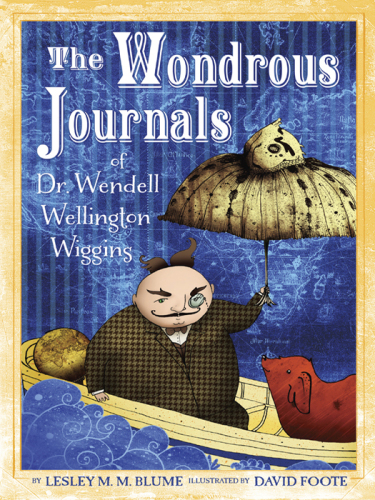
The Wondrous Journals of Dr. Wendell Wellington Wiggins
فرمت کتاب
ebook
تاریخ انتشار
2012
Lexile Score
970
Reading Level
5-7
ATOS
7.6
Interest Level
4-8(MG)
نویسنده
David Footeشابک
9780375899188
کتاب های مرتبط
- اطلاعات
- نقد و بررسی
- دیدگاه کاربران
نقد و بررسی

June 18, 2012
The team behind Modern Fairies, Dwarves, Goblins, and Other Nasties (2010) returns with another whimsical account of creatures strange and surreal, designed as a series of journals written between 1850 and 1885. The story follows mustachioed explorer Wiggins, “the greatest paleozoologist of all time,” as he travels the world, continent by continent, in search of prehistoric wonders and long-extinct species. His journeys turn up several oversize creatures (including island-sized whales and 10-story sloths), as well as animals one might classify as evolutionary missteps, like glowing bats and two-headed buffalo. There are also previously unknown branches of humanity, like Camel-Backed Geyser Geniuses, Goldeaters, and Hummingbird People. Wiggins’s findings are detailed as journal entries—accompanied by Foote’s comically stylized scientific illustrations and footnotes that contextualize Wiggins’s discoveries—often capped by pithy sayings (regarding the demise of the Gossip Peacocks: “sharp teeth always seem to win out over a sharp tongue”). This is less a story than a glorious unveiling of the long-hidden and very weird “history” of life on Earth. Ages 8–12. Agents: (for Blume) Jay Mandel, William Morris Endeavor; (for Foote) Jennifer Rofé, Andrea Brown Literary Agency.

May 15, 2012
The creators of the helpful guide to Modern Fairies, Dwarves, Goblins & Other Nasties (2010) now present the equally instructive, long-lost travel journals of a tubby but indefatigable paleozoologist with an unexcelled genius for unearthing uncanny, if long-extinct, animal and humanoid species. Systematically journeying to every continent between 1850 and 1885, Wiggins reports on over three dozen fossilized finds. These include "Thunder Vulcusts" (think vulture-locust), massive-limbed but "Pin-Headed Desert Giants," and "Dreaded Gossip Peacocks" with ears and mouths as well as eyes on their feathers. The "Two-Headed Mammoth Buffalo" has a carnivore at one end and an herbivore at the other ("The whole arrangement reminded me of a marriage," Dr. Wiggins notes jocularly). He also discusses centipede-like "Land Whales," such as the one underlying Nantucket Island. The doctor proffers homiletic speculations about how each species came to its unfortunate end (the buffalos, for instance, probably ate themselves, just as we "are always biting off our own heads") and provides sketched reconstructions of many specimens, with handwritten labels pointing out salient physical features and a human figure, usually tiny, for scale. The satire is neither as sharp as Dr. Swift's nor as comical as Mr. Lear's, but the fictive author's discoveries should, as he hopes, "enlighten, amuse, appall, and guide" young fans of the biosphere's imaginary reaches. (Informational fantasy. 10-13)
COPYRIGHT(2012) Kirkus Reviews, ALL RIGHTS RESERVED.

October 1, 2012
Gr 4-6-In 1850, shortly after completing his graduate studies, Dr. Wendell Wiggins sailed from England on a scientific mission that would occupy the remainder of his life. Wiggins believed that life on Earth was much more ancient than was generally assumed-predating the known paleologic eras by millions of years. For 35 years, he explored the remote corners of the world, seeking the relics of these ancient creatures. Now, in his recently discovered journals, the world's greatest paleozoologist describes his arduous travels and astounding discoveries. Accompanied by his pet Gibear, an odd, furry little creature with seemingly mystical powers, the doctor treks from continent to continent in his quest for prehistoric remains. He finds them everywhere-from the Amazonian Umbrella Fish to the Brittle Bones of Cornwall. Written in chatty diary style, the journals often draw moral parallels between contemporary society and the fossil record. For example, Wiggins records that the Two-Headed Mammoth Bison of ancient Nebraska had both herbivore and carnivore heads and ultimately devoured themselves, demonstrating that people are often their own worst enemies. The journals are a fascinating mixture of whimsy and reality. While the prehistoric creatures are wildly fantastic, the settings-from Yellowstone to Antarctica-are real places. References to historical figures and events are sprinkled throughout. Authentically rendered antique maps, sepia-toned pages, and annotated "hand-sketched" illustrations, complete with mock-Latin classification names, enhance the impression of a rediscovered antique travel record. An amusing science fantasy with some subtle but incisive commentary on modern civilization.-Elaine E. Knight, Lincoln Elementary Schools, IL
Copyright 2012 School Library Journal, LLC Used with permission.

























دیدگاه کاربران